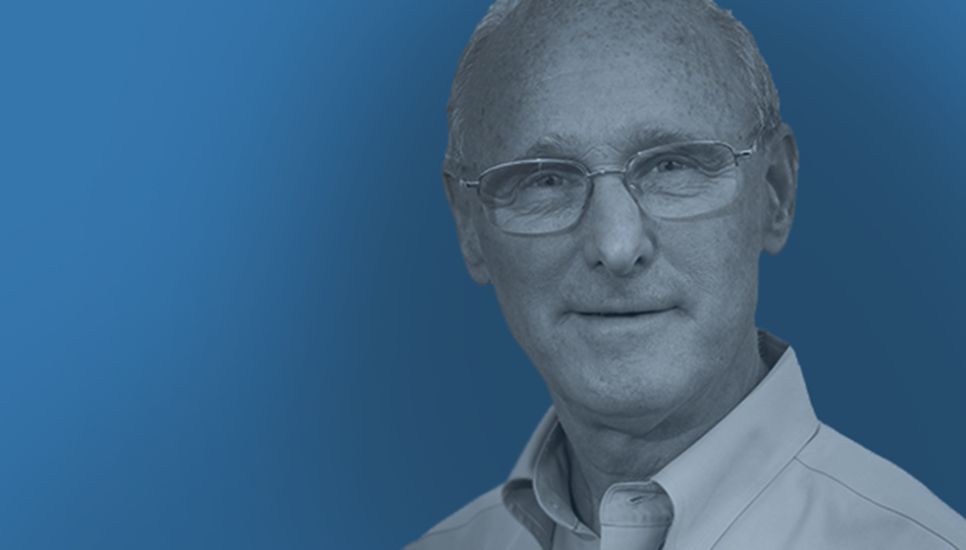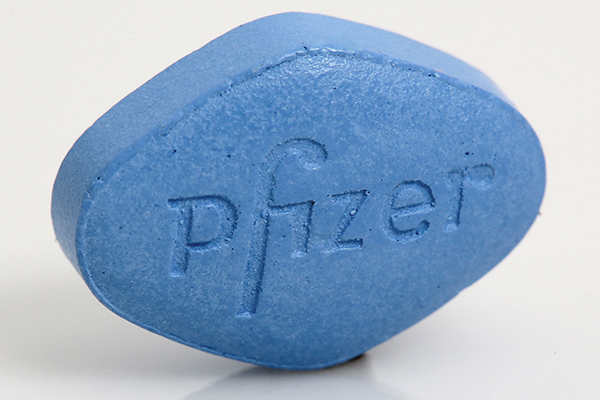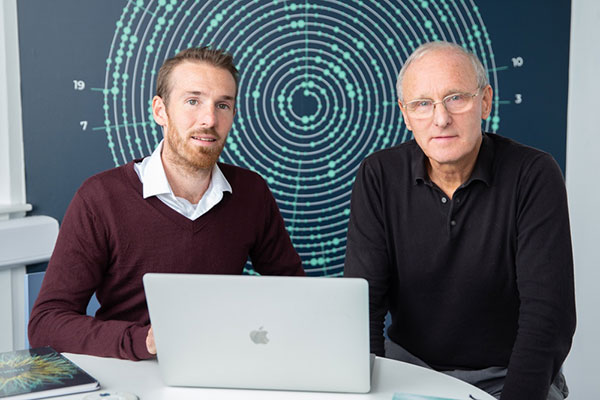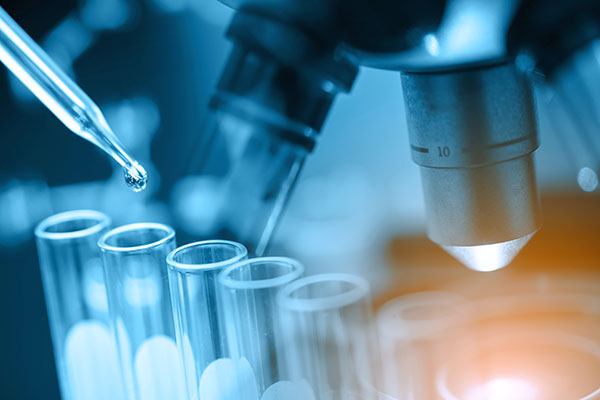Dr. David Brown: How Viagra opened the doors to machine learning innovation

Throughout his storied career, Dr. David Brown has made significant contributions to medical research within the pharmaceutical industry, but perhaps his most famous innovation came about through a chance observation when the angina medication he was working on had unexpected applications.
While working for Pfizer, he was named co-inventor on the patent for Viagra and, for eight years, led the team that developed the hugely successful erectile dysfunction medication into one of the bonanza breakthroughs of the century.
Having also shepherded the release of migraine medicine Relpax and pulmonary arterial hypertension treatment Revatio, Dr. Brown’s work is responsible for sales in excess of $50 billion.
Dr. Brown has since parlayed his extensive medical experience and head for business as co-founder of the antibody company Crescendo Biologics and co-founder and chair of the board of Healx, a fast-growing Cambridge University spinout company which uses machine learning to find treatments for children with rare diseases.
In an exclusive interview with Campden FB, Dr. Brown talks about his passion for entrepreneurialism, the mind-blowing benefits of machine learning and how big pharma needs a change in mindset…
“With Viagra, it was a chance observation that angina patients were reporting, so at Healx we thought why don't we learn from that?”
How did the ‘chance’ Viagra discovery shape your subsequent approach to innovation?
Healx is guided by what happened with Viagra. You need several things to come together at the same time to make a big breakthrough. First is selection of a disease of interest for drug discovery; second is designing the drug molecule; third is knowing the mode of action for how the drug works in treating the disease; and the fourth is direct linkage of the drug and its mechanism of action to efficacy in patients as early in the drug discovery process as possible – to reduce the failure rate in clinical trials.
As remains standard practice in the industry, those things were initially done sequentially with Viagra, But then we made the breakthrough after eight years’ work when suddenly all four came together with the clinical observation of erections. That observation directly linked erections to the drug, and therefore also to its mode of action, and identified the correct disease the drug molecule could treat. With the machine learning at Healx, we’re doing all those things in parallel (not sequentially) right up front, which massively de-risks the research and gives a greater chance of inventing truly breakthrough medicines, the Viagras of the future.
With Viagra, there was no core human bias involved in matching the drug molecule to the disease. It was a chance observation that the angina patients were reporting, so at Healx we thought why don't we learn from that?
With machine learning based on ‘omics of disease signature from patients, we can match in silico the disease, the drug molecule, and the mode of action in a single step, together with an enhanced probability of success in the clinic. It’s a whole new way to redesign the drug discovery process.

As a coach at Cambridge University Business School and a board member for a number of start-up companies, it’s clear that you have a passion for entrepreneurialism, where does this come from?
I think it was my family environment. Many of my relatives built their own businesses, despite having no formal education; they were either farmers or craftsmen. My father grew up incredibly poor but built his own business. Now I do everything I can to support small businesses, I really understand how tough it is and appreciate what they're doing. Our economy and employment depends far more on small businesses than big businesses, so I just have enormous respect for these people.
When I finished in big pharmaceutical companies after 30 years, I took on the role of chief executive of a small German start-up. I helped to raise $30 million in my first winter and later it was sold to GlaxoSmithKline. Since then, I've been interested in building small businesses and it's more natural to me than working in big companies. Small teams working together just get on with it and make things happen, whereas big companies spend so much time in meetings and personal effort can be compromised by internal politics and infighting.
I remember Richard Sykes, the CEO of GlaxoWellcome in the 1990s, when he selected me for training towards board level, said, “You know, half the people who get to senior levels are good at the job. The other half are just bloody good at the infighting.”
Whether a company succeeds or fails depends very much on which half gets control. I got sick of the infighting and I find that the need to survive in a small company makes people work together much more effectively, as every decision they make has an impact - that just isn't true in a company of 100,000 people.
“Viagra was the least resourced project at Pfizer, yet turned out to be the biggest winner, and they've never invented a drug themselves as big since then.”
Has your success with Viagra, Relpax and Revatio made it easier to raise investment for endeavours like Healx?
I think so. If people don't understand very deeply how drug discovery is done at the moment and what the weaknesses are, they haven't really got much chance of transforming it. The wiser investors we speak to know the inefficiency of the current methods and that a paradigm shift is needed.
I'm 73 years old and these successes helped me early in my career, but now it's down to Tim Williams, the CEO of Healx, and the team. They're not disconnected from the commercial prospects, because everybody understands we've got to raise money and everything’s got to be very commercially oriented. That focus is too often missing in research departments in big companies.
Viagra was the least resourced project at Pfizer, yet turned out to be the biggest winner, and they've never invented a drug themselves as big since then.
For me, it's easier to work with Healx, because I'm very money and commercially-orientated myself. Machine learning is no different from drug discovery and investing on the stock market… In all of them, you're analysing data, looking at patterns, trying to figure out what's going to happen and you have to balance reward to risk in your favour. It's the same mindset, whether it's drug discovery or the stock market.

What are the benefits of machine learning when it comes to medical innovation?
If you want to improve invention of new medicines, you've got to have new ideas about how to do it. Machine learning basically takes data and analyses it mathematically at a speed and scale that humans can't compute.
There's no doubt that the scale at which we can analyse data and find patterns is beyond what a human mind can do. For instance, we're going into clinical trials focussing on Fragile X syndrome [a genetic disorder that occurs in approximately 1 in 4,000 males and 1 in 8,000 females]. It's what we call a single gene defect disease and there are no drugs to treat it at the moment. Now we can look at the difference between the functioning of that defective gene and a normal state gene and we'll find a drug that corrects the wrong instructions from that gene.
While we can’t do this sort of analysing for common colds and heart disease, we can analyse genetic defects in Fragile X syndrome effectively and the resulting disease is driven totally by that gene. We know the DNA defects but, of course, it's what the DNA is doing that's important. DNA produces RNA (Ribonucleic acid), that's what's called the transcriptome, and then the RNA produces the proteome and that produces your metabolism. Information from any of those layers can be fed into machine learning algorithms if there's the appropriate data around.
If you look at the difference between patients with Fragile X syndrome and a ‘normal’ person and see which genes are being overexpressed or under expressed in the disease state, you can't really analyse that in your head it has to be computerised because it's such a massive amount of data. Then you look for a drug that reverse that disease signature. It's a simple concept and it works very well for single gene defect diseases. That was the very first technology we developed in 2015 for Healx and it's still one of my favourites.
The level of data handling and computation involved is just beyond the capabilities of the human mind… If one person worked their whole life, maybe they could come up with something. But with machine learning, we can do that in a few weeks and come up with a molecule that that could reverse the disease state.
“The reason Big Pharma can't do [machine learning] so easily it is that most people are terrified of the technology, they don't know how to use it and they don't trust it.”
BioTech is very much being led by independent thinkers and focussed start-ups. Why isn’t big pharma leading the charge?
I tried developing these technologies particularly in Pfizer, and it's like a bolt on to the current process… It doesn't change the process. Whereas, if you build a company from the bottom up, where the foundation is the machine learning, everything flows out and you've changed the whole structure.
The challenge for us is bringing in people who can work at the interfaces of machine learning and the drug discovery. The reason Big Pharma can't do it so easily it is that most people are terrified of the technology, they don't know how to use it and they don't trust it.
An analogy I often use is Kodak, who, believe it or not, invented digital photography but they didn't realise that within a few years it was going to change everything. Eventually they went bankrupt after digital camera phones started to be released… It's difficult to change a process that's worked in the past, it’s very tricky to change a juggernaut.
The big pharma companies are starting to buy start-ups but it would best to let them live independently and not merge them into the main company. They need to stay independent to do their own thing.

What do you think the biotech landscape will look like in ten years?
I go to a picture in my mind which I call the ‘S curve of technology development’. The flat bit at the bottom of the S is what's called the induction phase. The upward slope is the payback phase. And then that flattening slope at the top is the senescence.
I started presenting this ‘S curve’ at science conferences many years ago and asking the scientists ‘You invent a new technology, how long does that induction phase at the bottom last and how long before it starts to pay back?’
They said three to five years. But the answer is a generation, 15 to 25 years. So, for instance, the genomes that were being sequenced in the late ’80s and early ’90s, people started using them for this current target-based drug discovery in the mid ’90s and it wasn't ready. Biotechnology shares suddenly took off in 2013/2014, so actually, it was about 20-25 years from the beginning of the work on the genome to when it started to be useful.
Do you find that Biotech investors are still chasing the next big Viagra-style breakthrough?
Yes, I think they're all chasing it. And, as chair of the Healx board, my primary responsibility is to ensure investors get a return on their investment… If they succeed, we all succeed.
The range of technologies is so enormous but how do you know which ones are going to work? Drug discovery in the human body must be about the most complex thing in the universe… I used to say that we understand 5% of the human body, now I honestly don't think we know even that much. Everything is so complicated and so interrelated, so it’s very difficult for investors.
One of our investors in Healx has sometimes asked me to look at companies and give an opinion on those he thinks he might invest in, and I really struggle. Some of them haven't got much of a chance, but the ones that have got a chance comes down to the people as much as the technology and how they're applying it.






